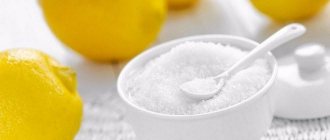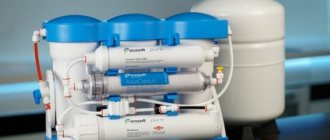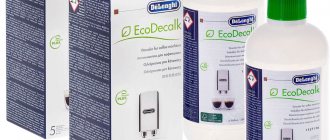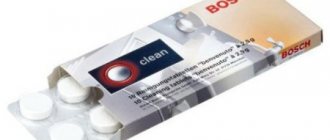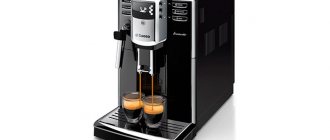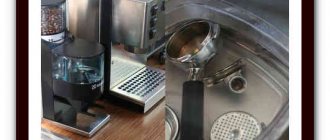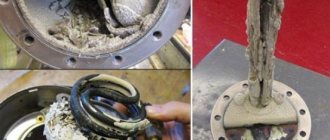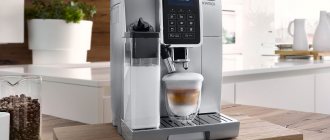Instructions for descaling different types of coffee makers
The method for descaling a coffee maker depends on the design of the device.
Machines with a removable filter and brewing unit can be easily washed under the tap in running water. If you regularly wash the device after making coffee, then thorough cleaning with citric acid or store-bought tablets can be done no more than once a month. Models with a built-in unit often have an auto-cleaning (decalcification) function, and if it is not provided, the scale is removed independently using a cleaning solution.
Most modern products are based on citric acid.
Descaling a drip coffee maker
- Wash the filter with warm water and a soft brush (unnecessary toothbrush) and return it to its place.
- Prepare a working liquid from citric acid: dissolve 30 g of crystalline powder in 4 glasses of warm water.
- Pour the solution into the water tank. Add cold water to the tank up to the Max mark.
- Turn on the coffee maker for 5-10 minutes. After 30 minutes, repeat the procedure and wait until the entire solution passes into the receiving flask.
- If there are still traces of scale on the filter, dip it in a hot solution prepared in the indicated way and hold for an hour.
- Rinse the filter well and replace it.
- Run clean water through the coffee maker several times until the acid comes out completely.
If the glass vessel for collecting the finished coffee becomes cloudy, you need to fill it with a warm solution and rinse thoroughly after 30 minutes with water.
Descaling carob, pod and capsule coffee makers
The operating principle of these types of coffee makers is almost the same, the only difference is in the design of the receiving device for coffee powder. Therefore, the descaling methods are the same:
- Unplug the coffee maker.
- Remove used coffee from the horn (holder).
- Wash the removable reservoir under running water and fill it with a solution of the product prepared according to the manufacturer’s instructions, or a solution of citric acid (according to the recipe described above). Allow the working solution to act for 15–20 minutes.
- Empty the pulp container.
- Empty the water from the drip tray.
- Turn on the coffee maker.
- Release approximately half of the heated solution through the cappuccino maker nozzle, turning on the steam mode.
- Pass the remaining solution through the empty horn (capsule holder) in the coffee preparation mode.
After removing the limescale, they begin to wash the inner surface of the coffee maker; the process consists of two cycles.
Rinse cycle for loading block and heater:
- fill the tank with clean water (up to the Max mark);
- start the coffee preparation program;
- Collect the rinsing water in a waste container.
Cappuccino maker rinse cycle:
- Fill the tank again with clean water (up to the Max mark);
- select and run the steam generation program. Collect the rinsing water from the cappuccino maker nozzle into a nearby container.
Cleaning with Auto Clean Mode
Modern coffee machines and coffee makers of the latest generation have an “automatic descaling” mode (decalcification). After completing the first 6 points of the algorithm described above for manual mode, you need to enable the “Auto Cleaning” function. The smart machine will do everything itself. All that remains is to add the cleaning solution or water by following the commands that appear on the device’s LCD display.
Helpful Tips:
- if the house does not have filters for water treatment based on ion exchange resins, use only bottled water with a salt content of 75 to 250 mg/l for brewing coffee;
- Do not mix solutions of branded products with citric or acetic acid;
- In order to clean the coffee maker from scale, it is prohibited to use abrasive products;
- Several servings of coffee brewed immediately after cleaning will have to be thrown away: they cannot be drunk.
Author of the article: Ilya Sokolov project manager, author of articles and editor-in-chief
Why is it better to choose lemon?
Positive aspects of the method
Citric acid is suitable for cleaning dishes and household appliances. It dissolves calcified formations in water.
Descaling a coffee machine with citric acid has its advantages. It does not contain aggressive toxins or flavors, so it does not cause allergic reactions. The exception is people with individual intolerance to the component.
Cleaning coffee machines from scale with citric acid helps remove all dirt. The substance also has a gentle effect on the mechanisms of the unit. Makes the equipment operate silently, which is considered a plus for a coffee machine.
Interesting! Top 7 best descaling products for coffee machines
Other benefits
A solution of citric acid increases the service life of the device and prevents its regular breakdowns.
Descaling a coffee machine with acid improves the aromatic and taste properties of coffee and makes the drink more concentrated.
The product does not pollute the environment. Suitable for coffee makers, Turks and other household appliances and utensils. This means it allows you to save on purchasing special cleaning powders for each item.
“Limonka” is a budget cleaning option. It costs 30-50 rubles in grocery stores, which is 3-10 times cheaper than professional detergents.
Negative points
Cleaning a coffee machine from scale with citric acid also has disadvantages.
Due to frequent cleaning, salt layers may form on the parts of the device. The product may corrode metal parts.
After treatment with lemon juice, a specific smell is formed that spoils the aroma of the first 2-4 cups of coffee. The taste of the drink also deteriorates.
Methods and products for cleaning a coffee machine
Decalcification
Using special cleaning products, the coffee machine device is decalcified. To do this, you should clean the device once or twice a year with decalcifying pills. They completely remove even the smallest deposits.
The most ideal option is to purchase a product for a coffee machine of a certain brand: Saeco, DeLonghi, Bosch, Krups. Produced from manufacturers, they are more expensive than regular ones from hardware stores, but they are more effective.
Can be used for decalcification:
- Cleansing pills,
- Aqueous products
- Citric acid.
How often should you clean your coffee machine?
Cleaning a coffee machine involves:
- descaling (decalcification),
- getting rid of coffee oils,
- cleaning the cappuccino maker and milk jug,
- care for other parts - the pulp compartment, millstones, tray.
It is important to clean each part of the device regularly and with a certain frequency.
How to understand when it's time to descale
When the time comes to decalcify, a corresponding message will appear on the device display or a special indicator will light up (see instructions). However, not a single coffee machine has sensors that would detect the amount of scale. The devices count the cooked portions and, upon reaching the milestone specified by the manufacturer, inform the owner about the need for cleaning. But the rate of scale formation directly depends on the hardness of the water: the more impurities it contains, the more actively salts are deposited on the heating elements. Therefore, before using the coffee machine, it is recommended to set the water hardness level. You can check this value using a special indicator strip that comes with the device.
The process of programming hardness for a specific coffee machine model is carried out in accordance with the instructions. And now the number of servings after which the device will need to be cleaned is determined depending on the specified indicator.
Some coffee machines equipped with a built-in water purification filter may not indicate at all that the device needs cleaning. A priori, it is believed that the liquid being poured is crystal clear and no scale is formed. But even in this case, experts recommend decalcification at least once a year.
The following “symptoms” indicate that it’s time to descale:
- the stream of coffee flowing into the cup is thinner than usual,
- white sediment in the drink,
- loud noise during operation of the device,
- The taste of the coffee deteriorates and its temperature decreases.
Frequency of getting rid of coffee oils
A pour-over type coffee machine is equipped with a brewing unit, which during operation becomes clogged with oils and particles of ground coffee. There are two types of infusers:
- Removable. It must be taken out and washed under running water once every 1–3 weeks. After preparing 200–500 cups of coffee, it is recommended to clean the device using special products.
- Fixed. It must be cleaned with special products immediately after the coffee machine gives the appropriate signal (see instructions).
Owners of espresso machines in which the horn acts as a brewing unit must daily:
- wipe the steam wand after each use of the device,
- After each cup of espresso, wipe the dispersion screen with a damp soft cloth,
- Wash the filter and holder (portafilter) after preparing the drink.
You also need to back-clean the valve 1-2 times a year or more often using a blind filter - a special filter without holes that is used to clean the brew group.
Cleaning other parts
Cleaning parts that many users forget about should also be carried out with some regularity:
- water collection tray - drain accumulated liquid daily, rinse completely 1-2 times a month,
- Compartment for collecting pulp - clean immediately after the device gives the corresponding signal,
- grinders - clean every 3-4 kg of coffee,
- cappuccino maker - every day, the part with both the built-in jug and the outlet tube must be disassembled (how to do this is described in the instructions for the coffee machine) and washed.
Is decalcification necessary?
Over time, almost a crust of limescale forms on the walls, and lime quickly corrodes everything: metal parts, and even more so, fragile plastic. But this will take a long time, but the water will quickly become tasteless, and moreover, harmful, since microorganisms and bacteria actively multiply in the porous structure of the plaque, and boiling does not kill them.
Signs that it's time to descale:
- Steam pressure has decreased;
- The coffee seems under-brewed;
- The drink has a musty smell and taste;
- The stream of pouring coffee became thinner;
- The sound of the coffee machine running became louder.
Some coffee machines are equipped with an automatic reminder that it is time to descale. This could be a message or just a flashing red light.
Automatic cleaning and washing of device parts
How to clean a machine that has the Auto Clean function built-in? Each coffee brewing unit has its own set of functions; it is ideal to purchase a machine with auto-cleaning. Naturally, the coffee machine should come with an instruction manual that describes how to start automatic cleaning. But if for some reason the annotation is missing, then this should be done as follows:
- 1 First, you need to empty the container and cleaner from the coffee.
- 2 Next, you need to pour water into the container and add anti-scale agent into it.
- 3 Then you need to start auto cleaning and watch the indicator.
- 4 Once 10 minutes have passed, you need to place the vessel and turn the spout through which steam is released to the right; the reddish indicator will light up.
- 5 Wash the tray to remove any drips, refill with water and place the container. Only this time the faucet must be turned to the left, thanks to which the internal cleaning of the system will be performed.
- 6 Wait until all the indicators light up, and this will signal that the coffee machine has been successfully cleaned.
This auto-cleaning should be done infrequently, but systematically. We must not forget about washing the body, drip tray, cappuccino maker and waste container.
It is not difficult to clean all the listed components; the body can be wiped with a cloth, and trays and containers must be washed under running water to remove dirt. It is recommended to place the cappuccino maker in a container with clean water and start the steam supply. As soon as untainted water flows, the cleaning is completed.
How to determine if an appliance needs cleaning
The main sign that the device needs cleaning is the appearance of scale, which gets into the finished drink and spoils the taste. Residues of coffee oil, scale and unwashed milk particles in the cappuccino maker are an excellent place for the growth of pathogenic bacteria.
The appearance of sediment in the cup is a reason for scheduled cleaning. In addition, you should be wary of bitterness in the drink, a thin stream when serving the finished drink, too loud operation and extraneous sounds when the machine is operating. Another sure sign is that the coffee takes longer to prepare.
In addition, many modern models of coffee machines are equipped with a sensor that shows the level of contamination. If this indicator turns on, it’s time to completely clean the device.
If the system has a self-cleaning option, fill the reservoir with water, add cleaning agent, start the process and follow the instructions that appear on the display. As a rule, this is a request to add water or re-clean a block.
Machines without self-cleaning require a different algorithm:
- clean filters and trays manually;
- Pour the cleaning agent into a suitable container with water;
- if you have a cappuccino maker, place a container under it for draining;
- start cleaning, add cleaning agent gradually;
- rinse all parts thoroughly under running water;
- Brew a couple of test portions of coffee, then pour them out.
When solving the problem of how to wash a coffee machine, you must first carefully study the instructions for the device you are using.
It is recommended to use test strips to measure the hardness of the water used and enter the data into the device.
There are several general rules for cleaning coffee systems, regardless of model.
General cleaning rules:
- Dissolve tablets and powders in water before use; mix liquid products with water; for capsule systems, use special capsules for cleaning.
- Remove the filter from the tank so as not to damage it with cleaning compounds.
- Use not only branded cleaners, but also alternative ones.
- After every 300-400 cups prepared, perform a complete cleaning, removing all parts of the device.
In addition to internal cleaning of the system, the external elements of the device also need care:
- Infuser – remove any remaining ground coffee with a sponge and warm water.
- Cappuccino maker - press the hot water release button, the water will wash away the milk residues. If the cappuccino maker is removable, it is better to remove it and rinse it under hot water.
- Holder (horn in a coffee machine) - wash in running water with a cleaning agent, after opening the horn with a screwdriver.
How to process individual elements?
In addition to the internal components, other elements of the unit also need regular cleaning. They become contaminated not only with lime from the water, but also with grains of coffee or milk.
Holder
It often develops a dark coffee coating. You can get rid of it by soaking it in hot water.
The duration of exposure should be about 15-20 minutes.
Difficult stains can be rubbed off at the end of treatment with the hard side of a foam sponge. Metal graters and scrapers should not be used.
Infuser
Cleaning is required much more often - approximately once every two weeks of active use of the unit.
- The unit must be removed from the device and washed with running water and a sponge.
- Dry and install back.
- If it is impossible to remove this unit (depending on the model), you should put a tablet for cleaning coffee machines in the coffee compartment, and place a small container under the horn.
- Start the drink preparation cycle and repeat it until the tablet is completely dissolved. As a rule, 4-5 repetitions of this operation are required.
- At the end, rinse the entire system several times with clean water using a similar scheme.
If you have a different brand of coffee maker, use the tips in this article.
How and why scale forms
Scale is deposits, hard in structure, formed on surfaces in contact with water during heating and boiling.
Deposits consist of calcium, magnesium, and iron salts contained in water. Water that contains a large amount of salts is called “hard”. Accordingly, the softer the water, the better it is suitable for household appliances with heating liquids. However, there are studies that say that using soft water is not always beneficial and can lead to pipe destruction due to the lack of a naturally occurring protective coating from salts.
Our water has average hardness, ranging from 3-9 mg/liter, where 3 is soft water, and 9 is very hard.
Water from natural sources is less suitable for use in household appliances, as it is often hard, which is why it has a unique natural taste.
How much does decalcification and refusal cost?
The most painful issue is financial. Many people think that decalcification is too expensive. Let's do the math.
- 800-1200 rubles for a bottle of branded cleaning liquid. It is enough for 1-2 uses.
- 150 to 500 rubles per bottle of a universal product.
- 200-450 rubles per pack of tablets, one tablet – one cleaning cycle.
We find that the cost of a cleaning “session” ranges from 50 to 600 rubles.
How much does it cost to not descale your coffee machine?
A burnt heating element will lead to replacement of the boiler, and this costs from 8-10 thousand without transportation costs.
Cleaning a machine without an automatic cycle
Don’t worry if your coffee machine doesn’t have a self-cleaning function or notification of the degree of contamination. Scale and coffee oils are removed using professional compounds and folk remedies.
Cleaning these parts does not require the use of professional compounds and large labor costs. It is enough to wipe the entire body with a soft cloth, and then rinse the tray and container under running water.
Rules for cleaning the cappuccino maker:
- lower a tube intended for collecting liquid into a container of water;
- turn on the hot steam supply (until exceptionally clean water appears).
Cleaning tablets for cleaning coffee machines are designed specifically to remove scale or coffee oils. Before choosing an effective method, you need to study the instructions from the device manufacturer.
The tablets should be dipped in filtered water and wait until completely dissolved, then you need to pour the concentrate into the container of the coffee machine to the maximum allowable length and select the function for preparing black coffee. If the mug is half full, you need to turn off the coffee machine for a quarter of an hour.
Special liquid household chemicals have shown high effectiveness in combating deposits in a coffee machine (Swipl, Topper Delonghi). General recommendations for use:
- Pre-prepare the solution according to the instructions, pour it into a water container;
- enable the self-cleaning function if available;
- start the system and open the tap, from which approximately 200-250 ml of water will flow out;
- repeat all the manipulations several times, draining 100 ml of liquid each time;
- Rinse the container under the tap after finishing the solution.
We suggest you familiarize yourself with Cleaning the toilet with electrolyte
Traditional methods
Procedure:
- turn off the device;
- take out a water container, wash it, add a few teaspoons of citric acid and fill in the required volume of liquid, the details of which are presented in the instructions for use;
- wait until the crystals are completely dissolved;
- install the tank into the device.
The subsequent tactics depend on the company that produces coffee machines of one type or another. You need to wait about 15 minutes until the acid begins to act.
Then it is important to start the coffee preparation process and do this one at a time until the compartment is empty. At the end, the machine is turned off, the water container is taken out and rinsed under running water.
Direct descaling is followed by the first and second rinse cycles.
What to use?
The care procedure is always described in detail in the instructions for the device. To remove contaminants, only specialized Delonghi products are used, which effectively remove scale and do not affect the taste of the finished drink.
The preparations can be used both for home units and devices intended for professional use. As a result, internal parts do not wear out and retain their original qualities.
All Delonghi cleaning products are sold in concentrated form and must be diluted with water. The exact proportions are indicated in the instructions. Usually 500 ml of product is enough for four applications.
The use of folk recipes and household chemicals is unacceptable due to the constant contact of internal elements with food products and the danger of destruction of parts due to aggressive influence.
Metal graters and scrapers are also prohibited. They scratch the surface and limescale deposits on it at a faster rate.
On our website you can also read about how to clean a Nespresso coffee maker, more details here.
How often should you descale your coffee machine?
Modern programmable models of coffee machines themselves inform owners about the need to cleanse. The display lights up: “Carry out decalcification”; in some models, the signal is a flashing red light. This function is found in complex, programmable coffee machines, and without descaling the device will not allow you to make coffee.
In programmable coffee machines, the water hardness setting is set by default and requires cleaning after preparing 100-120 cups of drink. If the water you use has a low hardness level, you will need to change the appropriate setting on your coffee machine manually. Working with soft water requires less frequent decalcification; the machine will have to be cleaned every 200-220 cups.
If your device does not have a notification function about the need to clean scale, then you can navigate by the time that has passed since the last cleaning.
- When using hard water, the coffee machine needs to be cleaned once every month and a half.
- Very soft water leaves much less sediment, so cleaning can be done every six months.
Signs of scale formation
There are indirect signs that will indicate the need for cleaning:
- The coffee flows into the cup in a thin stream.
- During operation, the device makes more noise than usual.
- The milk froth whips up more slowly, and its quality deteriorates; it becomes watery and not as fluffy.
- Water leaks into the pan.
To determine the condition of the system, perform a simple test - run water through the system without pouring coffee powder, and then carefully examine the contents of a cup of water passed through the coffee maker. If you see a whitish sediment at the bottom, then it’s time to descale the device.
Resourceful owners have invented an original way to determine the optimal period for cleaning a coffee machine. They simultaneously decalcify the kettle and coffee maker, and then monitor the condition of the kettle. As soon as plaque forms on its inner surface, it is time to clean the coffee maker. This method can be used if you use the kettle and coffee machine with approximately the same intensity.
Brief instructions for coffee machines with a display - Saeco, Gaggia, Spidem
SELECT PRODUCT READY FOR USE - The coffee machine is ready for use.
FILL WATERTANK - Add water to the water container (even if there is water in the container!).
COFFEE BEANS EMPTY - Add more coffee. If, after you have added coffee and pressed the button to make coffee, this message appears again, try making coffee again. If there are no changes, you should stop using the coffee machine and seek technical support.
ENERGY SAVING - The coffee machine has entered energy saving mode. Press any button to turn on normal mode.
Automatic cleaning of the coffee machine
Many expensive coffee machines have an automatic limescale removal mode. Using this function is very convenient, because it can be programmed according to the instructions.
How to rinse - algorithm of actions when the coffee machine is clogged:
- The water reservoir must be cleared of any remaining coffee beans.
- Next comes the preparation of the cleaning solution, as indicated in the instructions.
- Turn on the automatic cleaning procedure.
- After this, you can rinse the brewing unit with clean water.
- Start the drink preparation program; it is better to drain the first glass of liquid.
If there is no automatic cleaning in household units, descaling is carried out manually using products recommended by the device manufacturer.
Folk remedies
Cleaning with citric acid
This option is suitable for cleaning fresh scale. That is, one that has not yet formed a thick layer and has not become hard. Cleaning can be done on any kettle. Suitable for plastic, metal and glass. It is necessary to dissolve 2 tbsp. citric acid (fresh lemon will do) in 500 ml of water. The result will be a solution that is not very aggressive.
Execution order:
- Pour the liquid into the device and boil it.
- Pour in the acid or just take one lemon and squeeze all the juice inside.
- Wait two hours until the liquid cools.
- Shake to dissolve any limescale buildup.
- Pour the prepared mixture
Cleaning with soda
Soda contains phosphoric acid. It perfectly loosens salt deposits on the walls of the kettle. It is better to use colorless drinks, such as Sprite or Schweppes, so as not to paint the inside of the cookware. Before use, the gas must be removed from the drink. This will prevent foam from accumulating.
To do this, you can shake the bottle thoroughly, and then carefully open it, wait a couple of minutes until the abundant release of bubbles ends. Afterwards, the soda must be poured into the device, boiled, then wait until it cools completely. Afterwards we rinse the kettle.

